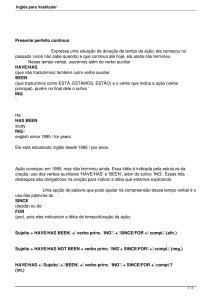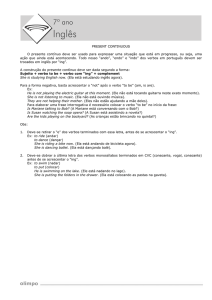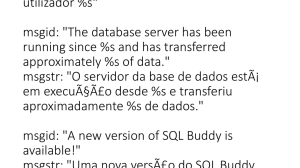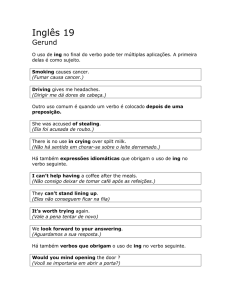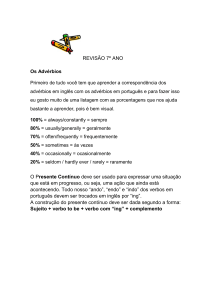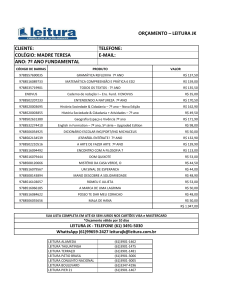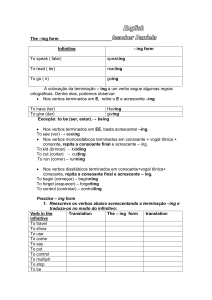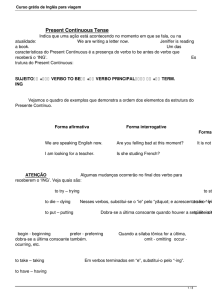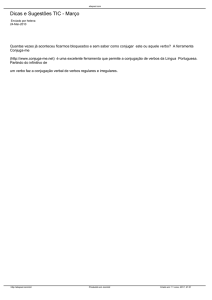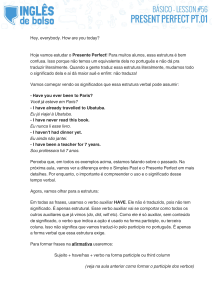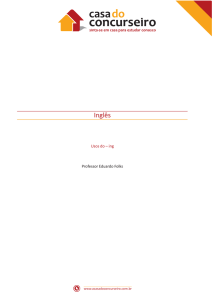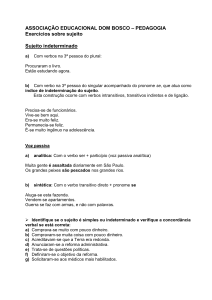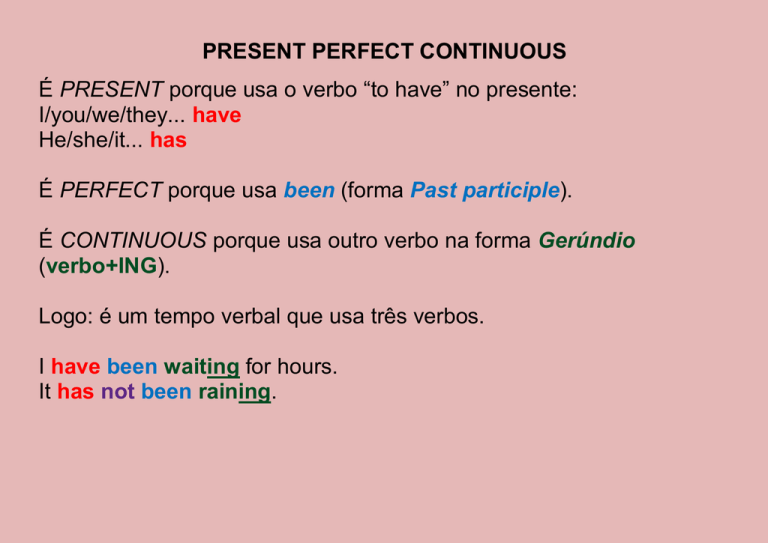
PRESENT PERFECT CONTINUOUS
É PRESENT porque usa o verbo “to have” no presente:
I/you/we/they... have
He/she/it... has
É PERFECT porque usa been (forma Past participle).
É CONTINUOUS porque usa outro verbo na forma Gerúndio
(verbo+ING).
Logo: é um tempo verbal que usa três verbos.
I have been waiting for hours.
It has not been raining.
Contrações:
I've been reading.
The car's been working properly.
We've been playing tennis for years.
I haven’t been reading.
The car hasn’t been working properly.
We haven’t been playing tennis for years.
QUANDO USAR?
Ação que começou no passado e está continuando agora, ou seja,
não se sabe quando vai acabar. Portanto são usados verbos que
exprimem ações duradouras, tais como: sit, stand, lie, live, work,
study, play, read, wait e rain (acrescidos de ING).
I have been reading for 2 hours.
We've been studying since 9 o'clock.
How long have you been learning English?
We have not been smoking.
AFIRMATIVA:
I/You/We/They + Have + been + verbo com ING.
I have been working all day.
He/She/It…+ Has + been + verbo com ING.
She has been living here for twenty years.
NEGATIVA
I/You/We/They+Have not/Haven’t+been+verbo com ING.
I have not been working all day.
He/She/It…+ Has not / Hasn’t +been+verbo com ING.
She has not been living here for twenty years.
INTERROGATIVA:
Have + I/You/We/They + been + verbo com ING + ?
Have you been working all day?
Has+ he/she/it…+ been + verbo com ING + ?
How long has she been living here?
OBSERVAÇÕES:
NÃO SÃO USADOS COM PRESENT PERFECT CONTINUOUS:
Ever, never, already, yet e just.
SIM: No lugar deles, usa-se:
Since: desde.
For: a/ por / durante.
REGRAS PARA ACRESCENTAR “ING” AO FINAL DOS VERBOS
1. REGRA GERAL = verbo (sem “to”)+ING. to work = workING
2. Os verbos terminados em E (make / write / drive etc) - tira-se o E e colocase no lugar dele “ing”. Eing: makING / writING / drivING
EXCEÇÕES:
a) To be = being
b) Os verbos terminados em IE (lie / die / tie etc.) – tira-se o IE e coloca-se
no lugar dele “ying”. IEying: lying / dying / tying
c) Verbos terminados em EE (agree) - regra geral, ou seja, verbo + ING.
agreeING
3. Verbos terminados CONSOANTE ou VOGAL + Y ( play / buy/ cry/ try etc)
– regra geral, ou seja, verbo + ING. PlayING / buyING / cryING / tryING
4. Os verbos curtos (3 ou 4 letras) terminados em consoante (C) + vogal (V)
+ consoante (C) (stop / get / run), ‘dobrar’ a última consoante:
stoppING / gettING / runnING
Verbos terminados em vogal (V) + vogal (V) + consoante (C) (wait / boil /
rain) – regra geral, ou seja, verbo + ING. WaitING / boiLING / rainING
Os verbos grow / flow também usam a regra geral, ou seja, verbo + ING.
growING / flowING
5. Os verbos Oxítonos (última sílaba “forte”) terminados em consoante (C) +
vogal (V) + consoante (C) (begin / admit / prefer / regret), ‘dobrar’ a última
consoante: beginnING / admittING / preferrING / regrettING
Quando os verbos são Paroxítonos (penúltima sílaba “forte”) terminados em
C+V+C (visit / limit / happen) , usa-se a regra geral:
visitING / limitING / happenING
AFIRMATIVA:
I/You/We/They + Have + been + verbo com ING.
He/She/It…+ Has + been + verbo com ING.
NEGATIVA
I/You/We/They+Have not/Haven’t+been+verbo com ING.
He/She/It…+ Has not / Hasn’t +been+verbo com ING.
INTERROGATIVA:
Have + I/You/We/They + been + verbo com ING + ?
Has+ he/she/it…+ been + verbo com ING + ?

